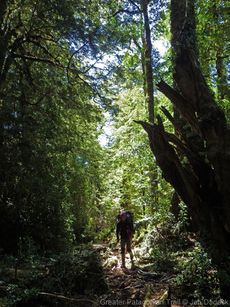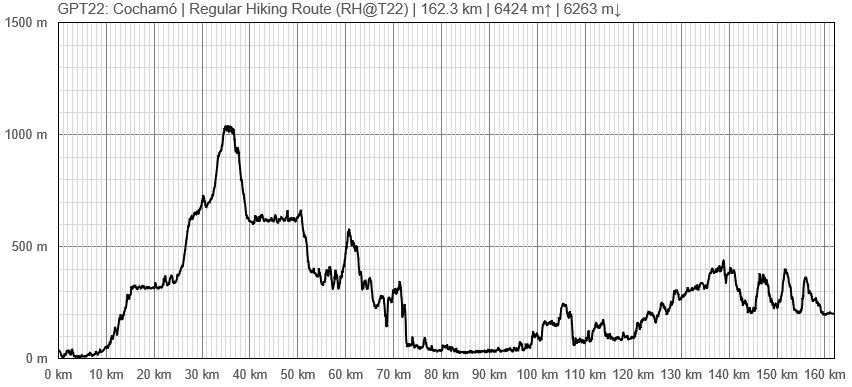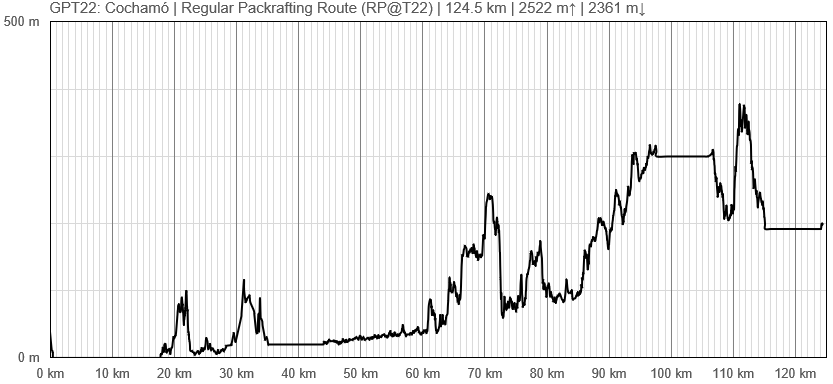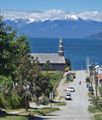GPT22 - Cochamó
|
|
|
| |||||||||||||||||||||||||||||||||||||||||||||||||||||
Recent Alerts and Suggestions
Season Section Log
Summary Table
Satellite Image Map
Elevation Profile
Elevation Profile of Regular Hiking Route
Elevation Profile of Regular Packrafting Route
Section Planning Status
Recommended Travel Period
Benefits of Hiking and Packrafting
Recommended Travel Direction
Section Length and Travel Duration
Suitable Section Combinations
Section Attractiveness
Section Difficulty
Resupply
Resupply Town
Shopping: Food
Shopping: Fuel
Shopping: Equipment
Services: Restaurants
Services: Laundry
Services: ATM and Money Exchange
Accommodation: Hostals and Hotels
Accommodation: Cabañas
Accommodation: Camping
Transport: Ground Transport
Transport: Ferries
Transport: Shipping Services
Resupply on the Trail
Location, Names, Available Items and Services
Access to Route and Return
Access to Start
The regular hiking routes crosses in the first part a hiking area that has grown in popularity in recent years. The large majority of visitors starts at the diversion from the main road (P22-4.3) or the trail head (P22-10.4) and walks only to the camp site La Junta (P22-20.8) from where they make day hikes into the surrounding area. The increased flux of hikers forced the operators of the camp site to establish a reservation system but the high demand during the peak season makes it difficult to reserve a spot on camp site between mid-December and mid-March on short notice. The operators of the camp site state that they may deny access to the trail if no reservation for the camp site was made in advance. I have asked the operator of the camp site if long-distance hikers without a reservation will be denied access to the trail even if they arrive early enough on the trail head to walk past the camp site La Junta to camp on one of the meadows or at the refuge several kilometers past La Junta. I did not get any answer. You should read to this subject: http://www.cochamo.com/reservationscamping/
This restriction substantially complicates a southbound traverse on the regular hiking route. A southbound traverse of this section also complicates arranging the 3 boat transfers over the Río Puelo (twice) and Río Traidor (once). Therefore I suggest hiking most of this section northbound even if walking generally in southbound direction. To flip the 120 km from Balseo Primer Corral (P22-119.9) to Cochamó (P22-0.0) you need to take twice the bus-ferry-bus combination between Cochamó and Primer Corral.
There is at least one daily bus-ferry-bus connection from Puerto Montt to Primer Corral. The bus leaves Puerto Montt in the morning (07:45 main bus terminal) and travels via Puerto Varas, Ensenada, Ralun (P21-67.1), Cochamó (P22-0.0) and the village Río Puelo to Lago Tagua Tagua. You can take this bus either on section GPT21 in Ralun (to avoid 15 km of road walking from Ralun to Cochamó), at the start of section GPT22 in Cochamó or in Puerto Montt after resupplying and resting in this larger town. For the bus schedule best ask any of the settlers along the route or see: http://www.cochamo.com/bus/
Should you start in Puerto Montt purchase your bus ticket in advance at the main bus terminal since this bus sells out quickly during the main tourist season.
At the terminal station you can board a ferry to cross Lago Tagua Tagua and take the minibus that travels the road from Lago Tagua Tagua via Llanda Grande to the settlement Primer Corral. Make sure to leave this minibus before the terminal station at the boat transfer point Balseo Primer Corral (P22-119.9). If arriving with this minibus at Balseo Primer Corral you are more likely to get immediately a lift over Río Puelo to start your hike of section GPT22 at the left bank of Río Puelo (P22-119.6).
Just before the Río Traidor at the Hospedaje Nancy (near P22-96.2, Radio Call Name: Base Traidor) you may ask the settlers Doña Nancy and Don Chindo how to best get over Río Traidor (either with their motor boat or with a neighbors paddle boat). The third and last river crossing you may arrange with the settlers Paulina and Jovino (P22-85.6, Radio Call Name: La Junta). Alternatively you may ask before the settler Ricardo Garado (P22-91.4, Radio Call Name: Cerro Mesa) if he gets you over Río Puelo on a cable car.
Most settlers along the Río Puelo have a radio to communicate amongst them. So you may ask most settlers in advance if they are at home to verify if a river crossing can be arranged. And please, don’t expect these river crossings for free but ask for the price in advance and pay without bargaining. You can avoid this 3 boat transfers only by taking the less attractive optional road short cut via Llanada Grande (to the right of Río Puelo) instead of walking on the recommen¬ded regular hiking route (to the left of Río Puelo). If taking this road short cut you miss one of the highlights of the GPT that gets you in contact and conversation with these settlers.
After the third river crossing you will be left near the settlers home of Señora Oco (P22-84.0, Radio Call Name: El Maiten) from where you can follow scenic trails to Cochamó (P22-0.0) at the starting point of section GPT22. Several settlers live along this route.
You should spend your last night BEFORE reaching the camp site La Junta (P22-20.8) i.e. at the refuge (P22-30.6) or at one of the two nice meadows before (P22-25.7 or P22-24.3) where you may pitch your tent for one night.
You may asked any of the settlers along the route if they sell some basic homemade supplies like bread, eggs and vegetables and if you are lucky may even purchase some luxury items like meat and beer. In particular if you camp near a settlers home or pay for accommodation fresh bread may be prepared for the next morning.
Once back in Cochamó take the same bus-ferry-bus combination to get the point where you flipped the hiking direction and continue southbound. The remaining part of section GPT22 can be hiking in any direction without comparable restrictions.
If hiking this section in southbound direction I strongly recommend to make a reservation for the camp site La Junta in advance. Once you reach the home of Señora Oco (near P22-84.0, Radio Call Name: El Maiten) ask her if she can arrange a river crossing with one of the settler nearby. When you reach the settlers home of Ricardo Garado (P22-91.4, Radio Call Name: Cerro Mesa) ask how to best cross Río Traidor. He may call by radio Hospedaje Nancy (near P22-96.2, Radio Call Name: Base Traidor) that is located closer to Río Traidor. When you reach Balseo Primer Corral (P22-119.9) ask the settlers nearby when you may get lift over Río Puelo.
Return from Finish
Escape Options
Permits, Entry Fees and Right-of-Way Issues
Regular Route
Regular Hiking Route
- Comment by Jan Dudeck after Season 2016/17:
The regular hiking routes crosses in the first part a hiking area that has grown in popularity in recent years. The large majority of visitors starts at the diversion from the main road (P22-4.3) or the trail head (P22-10.4) and walks only to the camp site La Junta (P22-20.8) from where they make day hikes into the surrounding area. The increased flux of hikers forced the operators of the camp site to establish a reservation system but the high demand during the peak season makes it difficult to reserve a spot on camp site between mid-December and mid-March on short notice. The operators of the camp site state that they may deny access to the trail if no reservation for the camp site was made in advance. I have asked the operator of the camp site if long-distance hikers without a reservation will be denied access to the trail even if they arrive early enough on the trail head to walk past the camp site La Junta to camp on one of the meadows or at the refuge several kilometers past La Junta. I did not get any answer. You should read to this subject: http://www.cochamo.com/reservationscamping/
This restriction substantially complicates a southbound traverse on the regular hiking route. A southbound traverse of this section also complicates arranging the 3 boat transfers over the Río Puelo (twice) and Río Traidor (once). Therefore I suggest hiking most of this section northbound even if walking generally in southbound direction. To flip the 120 km from Balseo Primer Corral (P22-119.9) to Cochamó (P22-0.0) you need to take twice the bus-ferry-bus combination between Cochamó and Primer Corral.
There is at least one daily bus-ferry-bus connection from Puerto Montt to Primer Corral. The bus leaves Puerto Montt in the morning (07:45 main bus terminal) and travels via Puerto Varas, Ensenada, Ralun (P21-67.1), Cochamó (P22-0.0) and the village Río Puelo to Lago Tagua Tagua. You can take this bus either on section GPT21 in Ralun (to avoid 15 km of road walking from Ralun to Cochamó), at the start of section GPT22 in Cochamó or in Puerto Montt after resupplying and resting in this larger town. For the bus schedule best ask any of the settlers along the route or see: http://www.cochamo.com/bus/
Should you start in Puerto Montt purchase your bus ticket in advance at the main bus terminal since this bus sells out quickly during the main tourist season.
At the terminal station you can board a ferry to cross Lago Tagua Tagua and take the minibus that travels the road from Lago Tagua Tagua via Llanda Grande to the settlement Primer Corral. Make sure to leave this minibus before the terminal station at the boat transfer point Balseo Primer Corral (P22-119.9). If arriving with this minibus at Balseo Primer Corral you are more likely to get immediately a lift over Río Puelo to start your hike of section GPT22 at the left bank of Río Puelo (P22-119.6).
Just before the Río Traidor at the Hospedaje Nancy (near P22-96.2, Radio Call Name: Base Traidor) you may ask the settlers Doña Nancy and Don Chindo how to best get over Río Traidor (either with their motor boat or with a neighbors paddle boat).
The third and last river crossing you may arrange with the settlers Paulina and Jovino (P22-85.6, Radio Call Name: La Junta). Alternatively you may ask before the settler Ricardo Garado (P22-91.4, Radio Call Name: Cerro Mesa) if he gets you over Río Puelo on a cable car.
Most settlers along the Río Puelo have a radio to communicate amongst them. So you may ask most settlers in advance if they are at home to verify if a river crossing can be arranged. And please, don’t expect these river crossings for free but ask for the price in advance and pay without bargaining. You can avoid this 3 boat transfers only by taking the less attractive optional road short cut via Llanada Grande (to the right of Río Puelo) instead of walking on the recommen¬ded regular hiking route (to the left of Río Puelo). If taking this road short cut you miss one of the highlights of the GPT that gets you in contact and conversation with these settlers.
After the third river crossing you will be left near the settlers home of Señora Oco (P22-84.0, Radio Call Name: El Maiten) from where you can follow scenic trails to Cochamó (P22-0.0) at the starting point of section GPT22. Several settlers live along this route.
You should spend your last night BEFORE reaching the camp site La Junta (P22-20.8) i.e. at the refuge (P22-30.6) or at one of the two nice meadows before (P22-25.7 or P22-24.3) where you may pitch your tent for one night.
You may asked any of the settlers along the route if they sell some basic homemade supplies like bread, eggs and vegetables and if you are lucky may even purchase some luxury items like meat and beer. In particular if you camp near a settlers home or pay for accommodation fresh bread may be prepared for the next morning.
Once back in Cochamó take the same bus-ferry-bus combination to get the point where you flipped the hiking direction and continue southbound. The remaining part of section GPT22 can be hiking in any direction without comparable restrictions.
If hiking this section in southbound direction I strongly recommend to make a reservation for the camp site La Junta in advance. Once you reach the home of Señora Oco (near P22-84.0, Radio Call Name: El Maiten) ask her if she can arrange a river crossing with one of the settler nearby. When you reach the settlers home of Ricardo Garado (P22-91.4, Radio Call Name: Cerro Mesa) ask how to best cross Río Traidor. He may call by radio Hospedaje Nancy (near P22-96.2, Radio Call Name: Base Traidor) that is located closer to Río Traidor. When you reach Balseo Primer Corral (P22-119.9) ask the settlers nearby when you may get lift over Río Puelo.
Regular Packrafting Route
- Route description by Kara Davis after Season 2017/18:
During this section, the Regular Hiking Route follows a heavy use trail to a well known climbing destination, La Junta. Due to the popularity of this hiking route, there is some necessary planning as well as rules and regulations that hikers must be aware of before embarking on this section. First of all, the trail to La Junta is not public. All hikers are required to register at the trailhead and the guards generally require proof that you made reservations to camp at La Junta in advance. To register, use this link: https://cochamo.com/reservationscamping/. Prices vary during the season but expect to pay 5.000 CLP to 6.000 CLP per night. The website states reservations should be made well in advance because of the camp’s popularity and to allow time to receive a confirmation email.
The route follows the paved highway, V-69, out of Cochamó until the turnoff onto the Cochamó-Paso El León dirt road. The La Junta trailhead is about 10.5 km from Cochamó. Keep in mind, NO ONE IS ALLOWED TO BEGIN HIKING ON THE TRAIL AFTER 15:00. There are two camps located at the trailhead which will host hikers for 5.000 CLP per night.
The trail to La Junta is obvious, but braided and muddy. Also, expect it to be crowded with other hikers heading to and from the popular camp. La Junta is located in a beautiful meadow with great views of the surrounding granite faces. This area is called the “Chilean Yosemite” for a good reason.
After La Junta, the trail ascends along the Río Cochamó. It remains obvious, but is still braided and muddy. There are several small areas to camp in the trees, and a few open fields. There is a decent place to camp is in a field south of the El Arco refugio. The trail to the field breaks off to the right just before the El Arco refugio, while the main trail passes very near to the refugio. The trail remains generally muddy until the descent to Lago Vidal Gormaz. There is a decent place to camp on the north side of the lake, but if you can make it to the south side, you’re in for a treat.
On the south side of the lake lives a lovely couple, Louisa and Mickey, who offer several services: boat transportation across the lake, camping (2.000 CLP/night), fishing, hot meals, and food to-go. As hungry hikers, we were not disappointed with the dinner Louisa served us. Most of the food was from the farm, and it cost only 4.000 CLP per plate.
The trail heading south from Louisa and Mickey’s place is mostly dry and there are several small areas to camp. Along Río Manso, about 8 km from Louisa and Mickey’s house, the trail alternates between sharp ascents and descents and is notably challenging. Locals with horses are common along the track since that is their only means of transportation to town.
There are several places to camp before reaching the gravel road about 3 km out from El Manso, but much of the area surrounding the road is private. There is advertised camping and a small store before the intersection with the larger gravel road (Lago Tagua Tagua—Llanada Grande) but both were closed when we passed through. At the intersection, there is another small store that offers snack foods, drinks, and some produce at reasonable prices. There is a hostel called El Monso with cabañas and camping options approximately 1 km down the road from the intersection.
A big feature on this section are three river crossings: two crossing of the Río Puelo and one of the Río Traidor. To reach the first Río Puelo crossing, turn off the main road (Lago Tagua-Tagua—Llanada Grande) at Señora Oco’s place (there is a sign and a gate). It is possible to arrange a ferry crossing with her. The river flows at the edge of her property, and can be reached by following a small trail. The current is strong, but ferrying across is straightforward.
The trail after the river crossing is muddy at times, but easy to follow. The Río Traidor crossing is about 9 km after the first Río Puelo crossing and is a much shorter and easier. Where the GPS route shows to cross over Río Traidor just before the confluence with Río Puelo requires hikers to climb over two barbed wire fences. About ½ km from the crossing is a farm belonging to Nancy and Chindo. They were very friendly and invited us in. They offer transportation across Río Traidor and I believe they may run a hospedaje out of their house as well.
The trail climbs after Nancy and Chindo’s house. It remains obvious, but is generally overgrown. There are areas where the forest opens up and camping is possible. Eventually the land completely opens up and the trail begins to travel through farmland. The trail is harder to follow through this area because it crosses other natural trails made by animal traffic and frequently becomes faint. There are many small stream crossings and swampy areas. Camping is plentiful in the open meadows, but this may put you in close range to the freely roaming livestock.
At the final crossing of Río Puelo, put in at a dirt boat ramp. Across the river, which is wide and has a strong current, there is a gravel boat ramp which leads up to a parking lot. The route continues on a dirt road that peels off the parking lot and climbs up to the east of the private residence (not the driveway at the south end of the lot). The route continues to follow a 4WD track, which reduces to an overgrown single track for about 7 km. The route then joins a dirt road, Camino Primer Corral—Llanada Grande.
After traveling down the road for about 200 m, the GPS track shows a sudden turn off to the east. However, when we asked the owner of the house located at the turnoff, she told us to continue east along the main road for 2.5 km, turn south on the smaller dirt road, and follow this for 2 km to rejoin the trail.
Eventually you’ll come across several signs indicating private property. The route continues past these signs but be sure to stay on the road. Follow the sign that says “Puerto Guala” onto a trail that curves to the west side of Lago de Las Rocas. There is a small dock located at the packrafting put-in. There is also a small campsite located a few hundred meters down the trail from here.
At this point, the route begins to head towards Argentina. The Chilean border control is located 1 km from the south bank of Lago de Las Rocas. In order to legally make it into Argentina, the control requires the dates on your exit stamp from Chile and your entrance stamp into Argentina to be the same. Since this is the case, the Chilean border control will not give you an exit stamp if it is late in the day since the Argentine border control station is about 12 km to the east. If you arrive late, it is possible to camp at the Chilean border control station.
The trail between the two border control stations is well maintained. The Argentine border control station is located about 4.5 km after the border. There is a nice camp spot here with a fire ring, toilets, and water.
The route continues along a trail which becomes faint and then disappears as you near Río Azul. This river crossing is substantial and should not be underestimated. The river is wide and crossing could be dangerous at high water levels.
Town: Lago Puelo/El Bolson
There is a popular campsite called Delta Del Azul with all necessary amenities on the north end of Lago Puelo. Camping here is nice but expensive. There are many camping options along RP16 towards Lago Puelo and El Bolson. Generally, campsite prices become less expensive the closer you get to El Bolson. The town of Lago Puelo offers several restaurants, places to stay, and good resupply options. There is also a bank with an ATM to withdraw Argentine Pesos from, but it does not seem to work for many foreign cards. If you find your options limited or are looking for cheaper prices, El Bolson is a quick 20 minute car ride north. This larger town has more options and several big grocery stores for easy resupply.

















